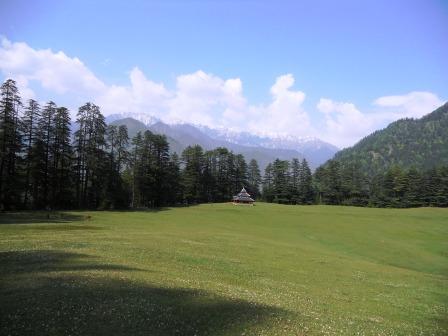
Kullu (Himachal Pradesh): If you are a professional trekker and want to test your nerves in the rugged and inhospitable terrain of the trans-Himalayas, the Great Himalayan National Park (GHNP) in the picturesque Kullu Valley is the perfect challenge for you.
Park authorities say it’s an ideal getaway for professional trekkers as it takes one from an altitude of 1,700 m to 5,800 m.
“The park offers a number of trekking routes, but for professionals only,” says park director Ajay Srivastav.
He said every year over 1,000 trekkers, mainly from European countries, trudge the park from May to October.
The GHNP, spread over 754 sq km and totally untouched by the road network, has four valleys — Tirthan, Sainj, Jiwa Nal and Parvati. The boundaries of the park are connected to the Pin Valley National Park, the Rupi-Bhawa Wildlife Sanctuary and the Kanawar Wildlife Sanctuary. The valleys offer moderate to strenuous treks.
More than two dozen trekking routes in the park have been identified and local youths have been trained to assist the trekkers, he said.
Park officials said a trek of the Sainj-Tirthan valleys is quite popular among the mountaineers.
“An eight-day 85-km Sainj-Tirthan trek is both moderate and strenuous,” an official said.

The Jiwa Nala-Parvati river valley 110-km trek is a seven-day hike, crossing the passes at Kandi Galu (3,627 m) and Phangchi Galu (4,636 m).
Likewise, the Pin Parvati pass (5,319 m) via Pulga is 90 km and requires eight days.
There are 14 inspection huts inside the park where the trekkers can camp.

“The trails in the eco-zone go through villages and are generally easy to moderate. The treks offer an opportunity to interact with the villagers and observe their daily activities, including weaving, basket making, cooking and farming,” he said.
The eco-zone contains 160 tiny villages with a population of about 15,000.
“Generally the Indians prefer to trek in the eco-zone. Around 20,000 trekkers come every year mainly from Maharashtra, Gujarat, Delhi and Karnataka,” he said.
More than 50 travel agents are based in Sai Ropa in Banjar tehsil for conducting activities in mountaineering, backpacking, skiing, trekking and rafting for students, families and corporates.
There is no entry fee for trekking in the eco-zones but for the GHNP, Indians have to pay Rs.50 per day and foreigners Rs.200.
The general climate is temperate during summer. In the winter, the possibility of snow storms is greater. Snowfall occurs throughout the park. There are 49 glaciers of varying sizes.
During the trekking, one gets the opportunity to spot a wide range of western Himalayan biodiversity.
The park, notified in the year 1999, is home to 203 bird species, including the western tragopan, the Himalayan monal, the koklas, the white-crested kalij and the cheer pheasant.
The famous mammals in the park are the leopard, the Himalayan black bear, the brown bear, the rhesus macaque and various herbivores like the goral, a small antelope, and the Himalayan tahr, a wild goat that lives on the steepest cliffs.
How to reach GHNP: The starting point for any visit to the GHNP is Kullu town. It is accessible by road and air.
By air: Regular flights from Delhi-Kullu (if weather permits)
By road: From Delhi 500 km (14 hours)
General route: Delhi to Chandigarh by national highway 1, then to Aut in Mandi district by national highway 21. From the small town of Aut, a road link crosses the Beas river into the Banjar valley, where the GHNP is located.
Photos by Ajay Srivastav
IANS
The opinions, beliefs and viewpoints expressed by authors, news service providers on this page do not necessarily reflect the opinions, beliefs and viewpoints of Hill Post. Any views or opinions are not intended to malign any religion, ethnic group, club, organization, company, or individual.
Hill Post makes no representations as to the accuracy or completeness of any information on this site page.


